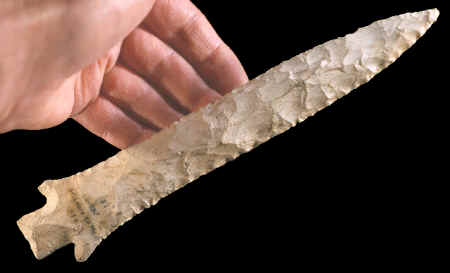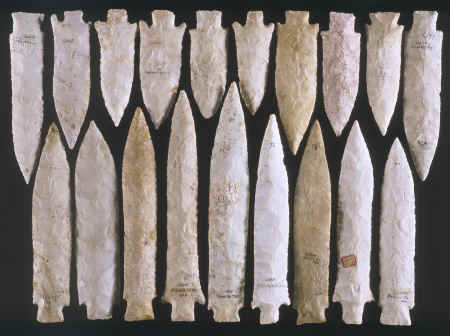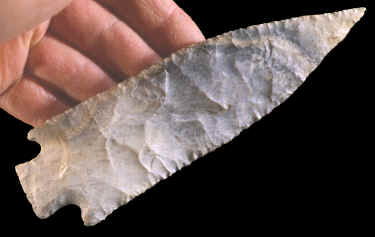|
"For some reason the Etley people had a need for a lot of large
blades."---2005, Alan
Banks, Central States Archaeological Journal, Vol. 52 April.
"Etley points are diagnostic of the Late Archaic Titterington phase
in the lower Illinois Valley."---1987,
Noel D. Justice, Stone Age Spear and Arrow Points.

CLICK ON
PICTURE FOR LARGE TRIPLE IMAGE
ETLEY
POINT
ST. LOUIS
COUNTY, MISSOURI
PRIVATE COLLECTION
This is a "classic" example of a large Etley point. It has recurved blade edges, wide strongly
barbed shoulders and a sharp point. This Etley point is made of white
Burlington chert and measures 7 1/2 inches (19 cm) long
and 7/16 inch (1.1 cm) thick.

ETLEY POINTS
LATE ARCHAIC PERIOD
ILLINOIS, IOWA & MISSOURI
One of the most impressive point types found in the Lower Illinois and the Lower Missouri River
Valleys and parts of the Mississippi
Valley are the Etley points. Their most recognized feature are their
large size . They are, on average, the
longest notched point type found in this region of the country.
|
|

ETLEY POINT
ST. LOUIS COUNTY,
MISSOURI
GLEN LEESMAN
COLLECTION
This is a "classic" example of an Etley point. For one
thing it's larger than most Etley points. It also has strongly
barbed shoulders, a straight and square stem and recurved blade
edges. This point is made from a course grained tan colored piece of
Burlington chert. It measures 8 1/2 inches (21.5 cm) long and 7/16
inch (1.1 cm) thick. |
|
|
Etley points date to the Late Archaic Titterington phase. Estimated dates for
Etley points have been reported from several different sites. These
dates range from 2000 B.C. to 550 B.C.
|
|

CLICK ON
PICTURE FOR LARGE IMAGE
GROUP OF 19 ETLEY POINTS
ILLINOIS AND MISSOURI
17 IN GLEN LEESMAN AND
2 IN PRIVATE COLLECTIONS
This picture shows a very good selection of 19 Etley points from
Missouri and Illinois. They illustrate a wide variation of size and
shape. Several have the artistic recurved blade edges. Others are
more straight and parallel sided with steeply angled edges towards
the point. Etley bases vary in style, from examples
that have wide and strongly barbed shoulders to others with small
shoulders and no barbs. Also notice the sharp points that Etleys are
noted for. The most obvious variation is the differences
in size. The Etley points in this picture range in size from about 4
inches to 9 inches long. All the examples illustrated here are made of Burlington chert. |
|
|
Etley points were named by Edward G. Scully
after the Oettle (pronounced Etley) farm in Calhoun
County, Illinois. Dr. Titterington first reported the site in 1950,
possibly from verbal accounts by Walter Wadlow who was excavating
burials on the Oettle farm. The difference in spelling, from Oettle to
Etley, was taken from Titterington's phonetic corruption of the land
owners name.
|
|

CLICK ON
PICTURE FOR LARGE TRIPLE IMAGE
ETLEY POINT
BOONE COUNTY,
MISSOURI
GLEN LEESMAN
COLLECTION
This "classic" Etley point is a very well crafted
example. It's slightly wider, thinner and more colorful that most
Etley points. It also has stylish recurved blade edges, strongly
barbed shoulders and a sharp point. The steeply angled blade edges
near the point indicate that it may have been resharpened
one or more times. This Etley point is made of multi-colored
Mozarkite chert and it measures 5 5/8 inches (14.3 cm) long. |
|
|
Etley points are fairly common. Some sites
have produced well over 100 points. For example, excavation of the
Hayden Etley site in Chesterfield, Missouri by a team led by Joe Harl
produced 172 Etley points. Another site in Cooper County, Missouri,
called the Bohon site produced 200 Etley points. It was reported that
116 of them were complete examples and 84 were broken bases.
|
|
CONTINUE ON TO PAGE
TWO
|
|
"REFERENCES"
1985,
Perino, Gregory, "Etley," Selected Preforms, points and
Knives of the North American Indians, p.127.
1987, Justice, Noel D., "Etley Cluster," Stone Age
Spear and Arrow Points of the Midcontinental and Eastern United States,
pp. 146-149.
2005, Banks, Alan, "Some Information on the Etley," Central
States Archaeological Journal, Vol. 52 April, pp. 90-98.
Personal communications with Glen Leesman.
|
|
RECENT
LISTINGS HOME
ORDERING |






